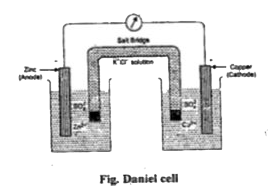Give the construction and working of Zn/CuSO4 or Daniel cell.Solution in Punjabi
Zn/CuSO4 or Daniel cell : This cell is based upon following spontaneous redox reaction.
Zn(s)+Cu2+(aq)→Zn2+(aq)+Cu(s)

The arrangement consists of two beaker, one of which contains a solution of zinc sulphate (say 1.0 M) and the other contains a solution of copper sulphate (say 1.0 M). A zinc rod is dipped in ZnSO4 solution while a copper rod id dipped into CuSO4 solution. these metallic rods are known as electrodes.
The two solutions are connected by means of salt bridge. A salt bridge is an inverted U-tube containing an aqueous solution of some i nert0 electrolyte, such as KCl,KNO3orK2SO4 to which some agar-agar or gelatin has been added to convert it into semi-solid paste. the ends of the U-tube are plugged with glass wool. when the two metallic rods are connected toa galvanometer by means of wire through a key, the reaction takes place on closing the key and the following observations are made:
(i) There is adeflection in the galvanometer which indicates the flow of electrons through connecting wires.
(ii) The direction of diflection indicates the flow of electrons is from zinc to copper.
(iii) The zinc rod loses mass, whereas copper road gains mass.
(iv) The concentration of Zn2+ ions in zinc sulphate solution increases while that of Cu2+ ions in copper sulphate solution decreases.
(v) The solutions in the two beakers remain electrically neutral
(vi) The reaction as well as flow of electrons stops after sometimes.
(vii) There is no evolution of heat during the process.
(viii) The masses of zinc dissolved and copper precipitate are in the ratio of their equivalent masses.
Mass of zn dissolvedMass of Cu deposited=Eq. mass of ZnEq. mass of Cu
Let us now consider the above mentioned observations in terms of of the cell. as zinc atoms undergo oxidation and get oxidised into Zn2+ ions by loss of electrons the mass of the zinc rod decrease.
Zn(s)→Zn2+(aq)+2e− (Oxidation)
The electrons so produced are pushed through the connecting wires to the copper electrode, there these are taken by the Cu2+ ions which get reduced to copper.
Cu2+(aq)+2e−→Cu(s) (Reduction)
The copper atoms so formed get deposited on the copper electrode. thus mass of the copper rod increases.
The overall reaction taking place int he cell is as follows:
Zn(s)+Cu2+(aq)→Zn2+(aq)+Cu(s)
The electrode at which oxidation takes place is called anode and the electrode at which reduction takes place is called cathode. in the above metioned cell, oxidation occurs at zinc electrode, therefore, zinc is anode, and reduction occurs at copper electrode, therefore copper is cathode. it may be noted that in an electrochemical cell anode constitutes negative termmeans and cathode constitutes positive terminal. by convention, the direction of flow of current is from positive terminal to negative terminal, which is opposite to the direction of flow of electrons.
Topper's Solved these Questions
- ELECTROCHEMISTRYBOOK - BETTER CHOICE PUBLICATIONCHAPTER - ELECTROCHEMISTRYEXERCISE - NERNST EQUATION
4 Videos
- ELECTROCHEMISTRYBOOK - BETTER CHOICE PUBLICATIONCHAPTER - ELECTROCHEMISTRYEXERCISE - CONDUCTANCE OF ELECTROLYTIC SOLUTIONS
21 Videos
- ELECTROCHEMISTRYBOOK - BETTER CHOICE PUBLICATIONCHAPTER - ELECTROCHEMISTRYEXERCISE - Numerical Problems
69 Videos
- CO-ORDINATION COMPOUNDSBOOK - BETTER CHOICE PUBLICATIONCHAPTER - CO-ORDINATION COMPOUNDSEXERCISE - QUESTION FROM PREVIOUS BOARD EXAMINATION
59 Videos
- GENERAL PRINCIPLES AND PROCESS OF ISOLATION OF ELEMENTS BOOK - BETTER CHOICE PUBLICATIONCHAPTER - GENERAL PRINCIPLES AND PROCESS OF ISOLATION OF ELEMENTS EXERCISE - Question Bank (6.6 OXIDATION-REDUCTION)
15 Videos
Similar Questions
State and explain Nernst equation.
View SolutionDefine Specific conductance.
View SolutionDerive Nernst equation for the following cell:
NiNi2+(0⋅2M)∣∣∣Cu2+(0⋅2M)∣∣Cu.
View SolutionWrite the IUPAC name of corordination compound [Co(NH3)3ONO]Cl2.
View SolutionName the process from which chlorine is obtained as a bye-product. What will happen if an aqueous solution of NaCl'is:subjected to electrolysis?
View SolutionPoint out the correct statement about Zn-CuSO_(4) cell.
View SolutionE∘Cu=0.34V,E∘Zn=-0.76V. A Daniell cell contains 0.1M ZnSO4 solution and 0.01 M CuSO4 solution at its electrodes. E.M.F. of the cell is
View SolutionWhich of the following is true in the case of Zn−CuSO4 cell ?
View SolutionThe emf of the Daniel cell using molar concentrations of ZnSO_(4) and CuSO_(4) solutions is
View SolutionThe emf (in V) of a Daniell cell containing 0.1 M ZnSO_(4) and 0.01 M CuSO_(4) solutions at their respective electrodes is (E_((Cu^(2+))/(Cu))^@ = +0.34 V, E_((Zn^(2+))/(Zn))^@ = -0.76 V)
View SolutionDescribe the construction of Daniel cell. Write the cell reaction.
View SolutionIn Daniel cell, the charges developed by Zn//Zn^(2+) and Cu//Cu^(2+) are ________
View SolutionDescribe the construction of Daniel cell. Write the cell reaction.
View SolutionDescribe the construction and working of Daniell cell.
View SolutionExplain construction of Daniel cell. Write half cell reactions. How is Daniel cell symbollically represented?
View SolutionExplain construction of Daniel cell. Write half cell reactions. How is Daniel cell symbollically represented?
View Solution
